NASA could thank Yuri Gagarin for the decision that sent U.S. astronauts to the moon. When the American press demanded to know how President John F. Kennedy planned to respond to the historic first flight of a human in space, the president, who had been barely tolerant of space exploration before Gagarin’s April 10 milestone, searched for an exploit that would outshine Soviet achievements. One month later, in a special address to Congress on May 25, 1961, Kennedy committed the nation to “achieving the goal, before this decade is out, of landing a man on the moon and returning him safely to Earth.” The address conferred the administration’s blessing on a quiet movement that had begun two years earlier when members of a Space Task Group, formed by the Eisenhower administration to answer the 1957 Sputnik launch, listed “lunar landing” as the goal around which their infant efforts could coalesce—this before the first launch of an unmanned rocket in the Mercury program. In January 1960, NASA space flight chief Abe Silverstein first used the word “Apollo,” to refer to spacecraft that would follow Mercury. Before Kennedy began drumming up support for the moonshot, many of the important players had assembled, and a plan had been sketched. With Kennedy’s endorsement, made over the objections of his science advisor, the clock started.

1961
August 9 | First, You Have to Find It
The first major contract of the Apollo program is awarded to MIT’s Charles Stark Draper Laboratory for the spacecraft guidance and navigation system. When NASA chief James Webb asked for assurance that the equipment would work, Draper offered to go along as a crew member to operate it.
The system included sensors, gyroscopes, and a digital computer—the first to use integrated circuits. In 1963, Apollo appropriated 60 percent of all integrated circuits produced in the United States. By 1966, the Draper lab had produced the guidance hardware; from then, until the Apollo 8 mission in December 1968, it focused on software, a word so new it had appeared in print for the first time only three years before the Draper contract was signed.
/https://tf-cmsv2-smithsonianmag-media.s3.amazonaws.com/filer_public/59/f8/59f87dc3-7eef-42ef-bd65-d002f0c0905f/05g_ce14_apollo2019_1961may25kennedyspeech_live.jpeg)
1962
September 17 | The New Nine
NASA announces its second group of astronauts. After the Mercury 7 came “the New Nine,” test pilots with high IQs (130 to 145) and some with advanced degrees. All, except two who died in accidents, commanded Apollo missions: Neil Armstrong, Frank Borman, Pete Conrad, Jim Lovell, Jim McDivitt, Tom Stafford, and John Young.
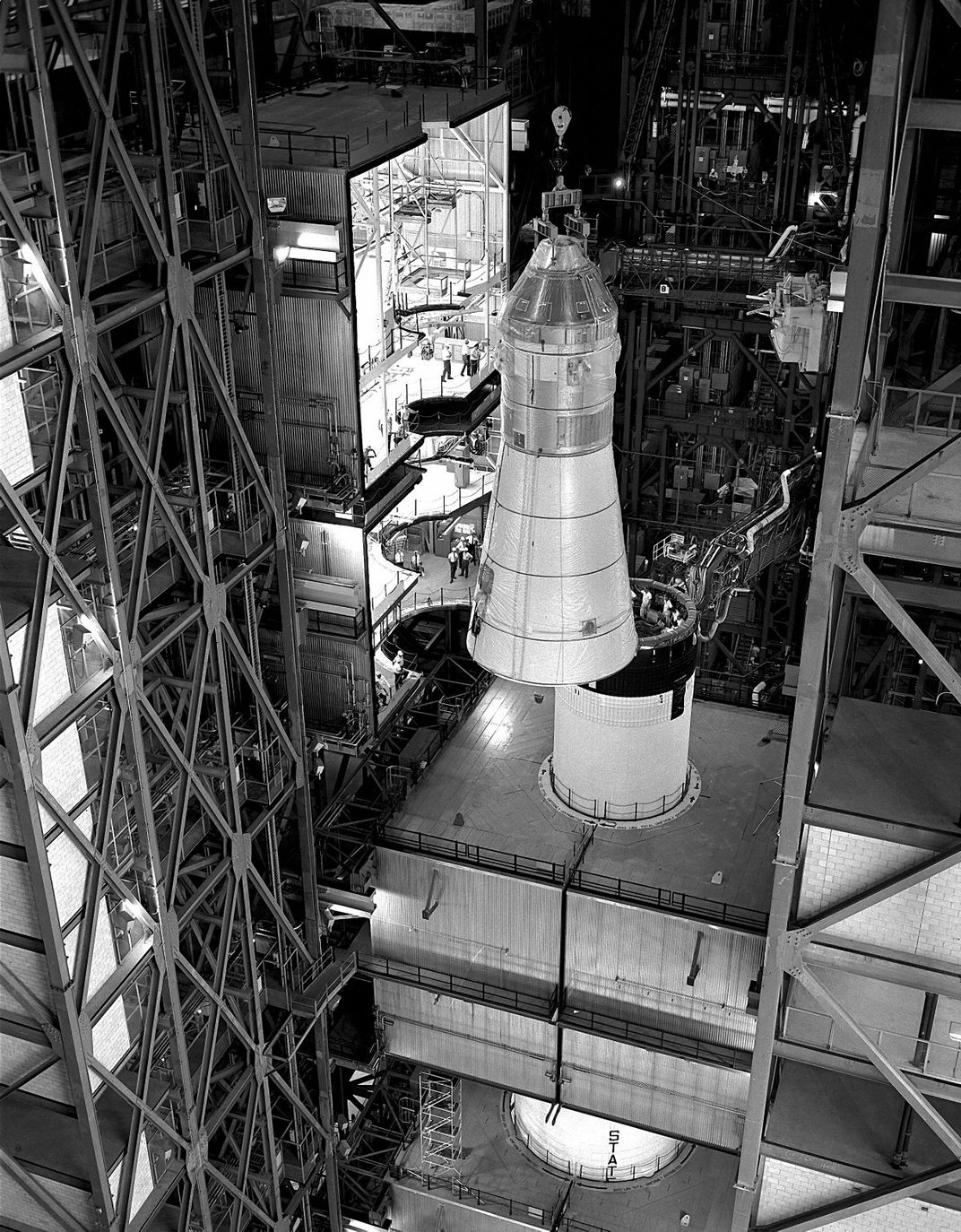
October 31 | Moonport
The Gahagan Dredging Corporation of Tampa begins clearing palmetto scrub and orange trees from Merritt Island to make way for the colossal structures required to assemble and launch moon rockets: the 525-foot-tall Vehicle Assembly Building (VAB) occupying eight acres (the Rose Bowl could fit on its roof), a launch complex with 350-foot-tall service structures and flame trenches 40 feet deep and 500 feet long, and crawler ways joining the two, over which would travel one of the largest machines ever to move on land, carrying the Saturn V rockets. The VAB rests on 4,225 steel pilings driven into the Florida bedrock.
1963
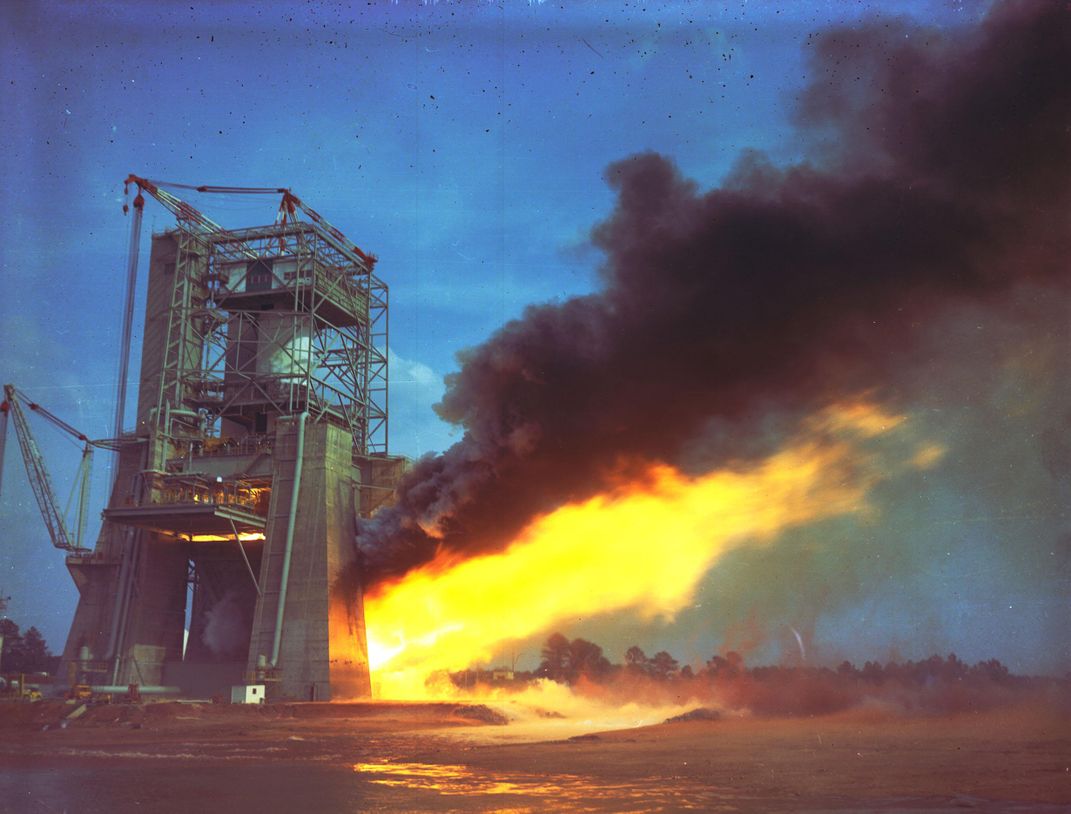
October 31 | World’s Most Powerful
Rocketdyne delivers the first production F-1 rocket engine to the Marshall Space Flight Center for qualification tests. It took another two years of effort by propulsion experts in industry, universities, and the government to perfect the Saturn’s first-stage, 1.5 million-pound thrust engine, the largest and most powerful liquid-fuel rocket engine ever built. One of the chief struggles was getting fuel and oxidizer to burn smoothly within the F-1’s vast combustion chamber. Combustion instabilities created such high pressures and heat that they destroyed the engine within milliseconds of ignition. After thousands of highly instrumented tests, the engineers discovered the optimum mixture ratio, pressure, and spray pattern. Yet because—as Rocketdyne’s chief propulsion engineer William Brennan admitted in 1967—the cause of the instability was never fully understood, no Rocketdyne engineer ever watched a Saturn V launch without worrying that the gremlin would strike.
1964
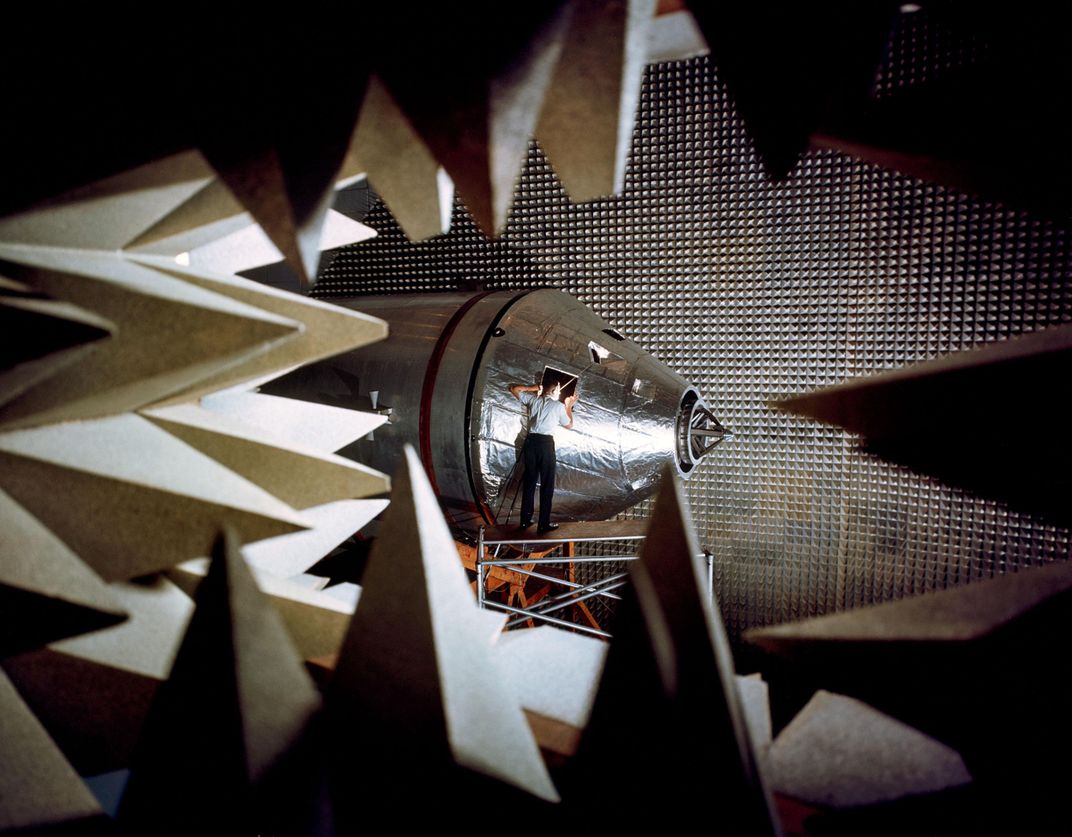
November 29 | Mothership
North American Aviation begins production of the Apollo Command and Service Modules designed to fly to the moon. NASA ordered three versions of the spacecraft from the California contractor: boilerplate test models, a Block I version for more tests and Earth-orbit missions, and the Block II moon voyager, which included mechanisms for docking with the craft that would carry astronauts from the mothership to the lunar surface. (North American would modify the design three years later following the investigation of the fatal Apollo 1 fire.) Inside its steel honeycomb skin, the Command Module held a pressure vessel serving as cabin and cockpit, an unpressurized forward, or top, compartment where parachutes and other landing equipment were stowed, and an aft, or bottom, section containing 10 reaction control motors. The capsule’s simple shape hid the complexity of its systems, but that complexity is revealed by the 24 instruments, 566 switches, 40 event indicators, and 71 lights on the spacecraft’s cockpit control panel.
1965
/https://tf-cmsv2-smithsonianmag-media.s3.amazonaws.com/filer/02/48/0248cc6b-eaff-4596-b072-e3d24b68b0af/05k_ce14_apollo2019_eva1965edwardwhite235794main_gpn-2006-000025_live.jpg)
June 3 | Spacewalk
A little more than four hours after astronauts Jim McDivitt and Ed White left Earth aboard Gemini 4, White becomes the first American to walk in space. Working in space with only the protection of a spacesuit was just one of the critical procedures that had to be mastered before NASA could send astronauts to the moon. Project Gemini was Apollo’s proving ground. The lunar voyage was expected to take at least a week; on Gemini 7 in December 1965, Frank Borman and Jim Lovell stayed in space twice that long. On Apollo missions, a landing craft would have to find the mothership in lunar orbit, fly to a rendezvous, and dock. Those requirements posed a tougher set of problems.
McDivitt and White were the first to face the challenge, but not understanding the orbital mechanics of rendezvous—that increasing speed to overtake the target would raise their spacecraft’s orbit and therefore slow them relative to the target—the crew abandoned the task after several bewildering attempts. Step by step over eight subsequent missions, however, the Gemini astronauts learned how to meet up, fly in formation, and maneuver their craft to connect in space.
June 3 | Mission Control
Beginning with Gemini 4, control of spaceflight shifts from Cape Canaveral to new facilities for Mission Control at the Manned Spacecraft Center in Houston. In the Mission Operations Control Room sat engineers who were expected to be experts on the myriad complex systems of the Gemini and later the Apollo spacecraft and were expected, should something go wrong, to keep the astronauts alive.
1966
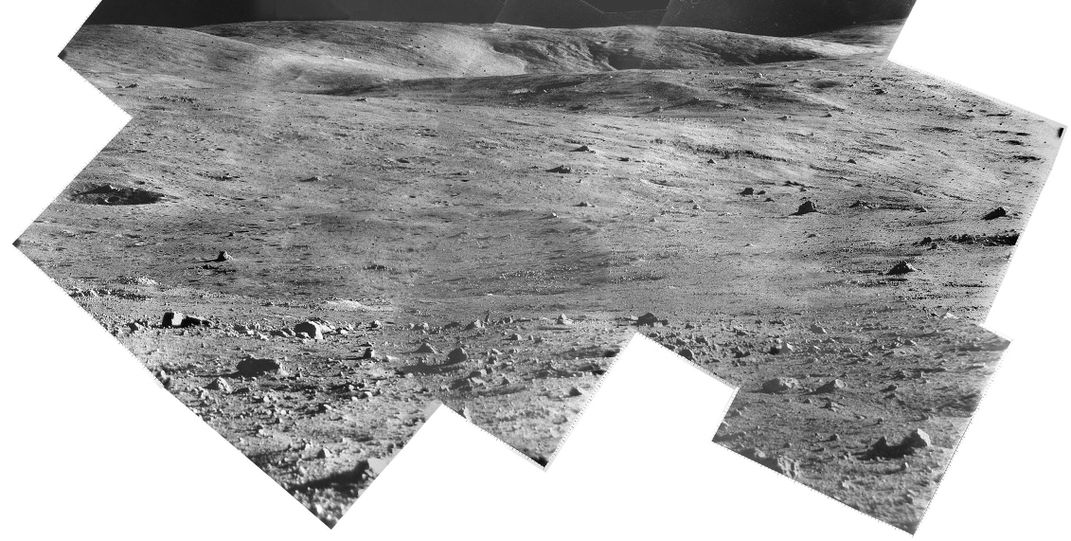
June 2 | Trailblazer
Surveyor 1 lands on the moon. The spacecraft, designed by the Jet Propulsion Laboratory (JPL), was flung by its Atlas-Centaur launch vehicle directly at its landing site in the moon’s Ocean of Storms, a two-and-a-half-day journey from Earth. At an altitude of about 59 miles above the moon, Surveyor ignited a solid-fuel descent rocket, which decelerated the craft to 240 mph. Further slowed and stabilized by three Vernier engines, the spacecraft touched down at about 10 mph.
What it would touch down on was the mission’s big question; in 1966, no one knew what the moon’s surface was like and whether the lunar crust would support the weight of a 16,000-pound Apollo Lunar Module (launch weight minus the descent-stage fuel). Surveyor 1 sent more than 11,000 photos, including some showing that its footpads had barely depressed the regolith. After the failure-prone Ranger program—only three of nine spacecraft returned images—JPL personnel and others approached the more challenging Surveyors with dread. One scientist estimated the chance of success at 10 or 15 percent. So the flawless performance of the very first Surveyor gave the men and women working on Apollo not only necessary information about the lunar surface but confidence that the moon was within their grasp.
1967
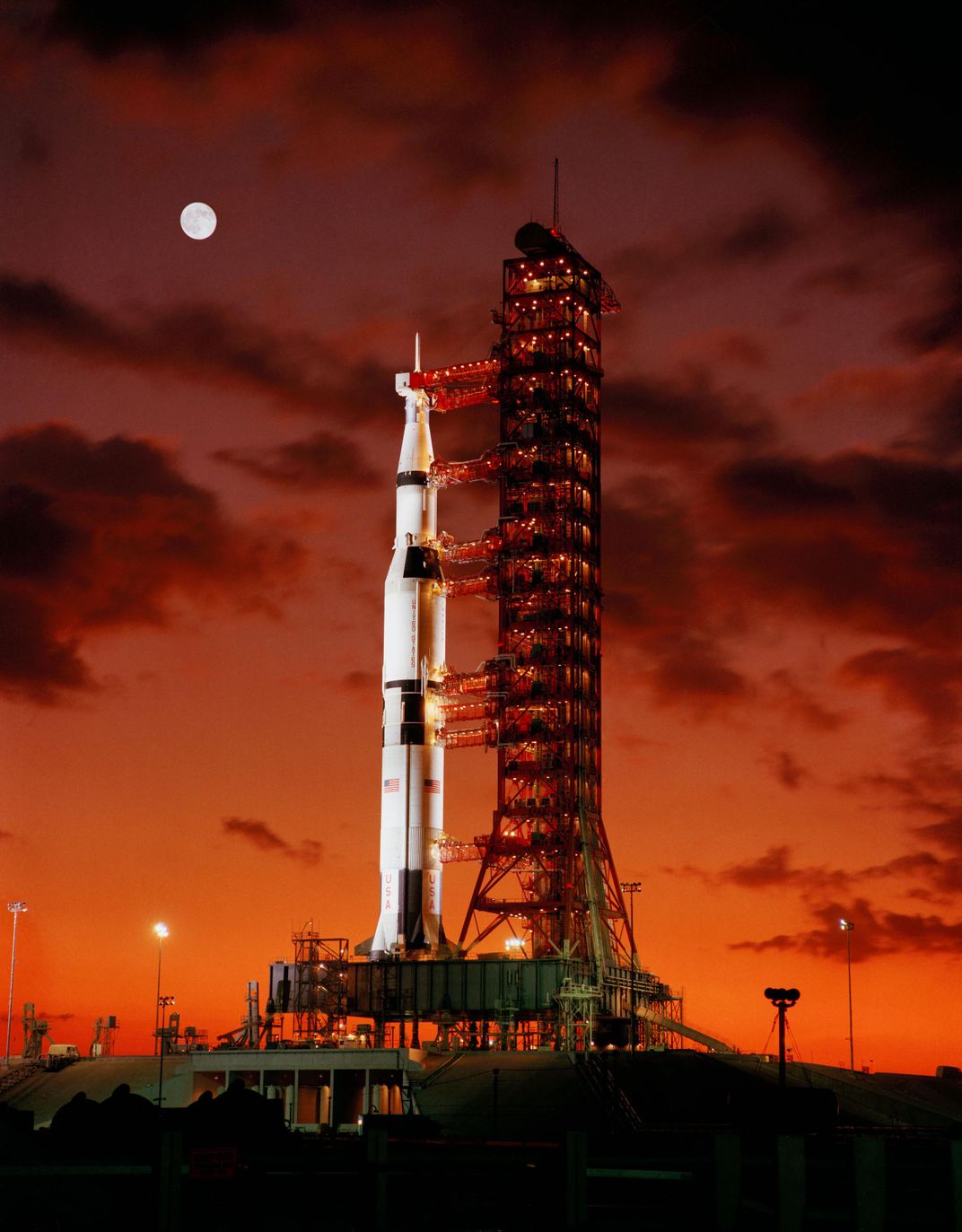
November 9 | Giant
The first launch of the Saturn V moon rocket is also the first flight test for two of its three stages. From Boeing, at the Michoud Assembly Facility near New Orleans, the immense S-1C first stage with its cluster of five engines came by river barge via the Intracoastal Waterway to the Kennedy Space Center. The S-II second stage, built by North American Aviation in Seal Beach, California, also traveled by barge, passing through the Panama Canal. Douglas Aircraft in Santa Monica, California, flew the third stage across the country in a specially built airplane known as the Super Guppy. When the three stages were stacked and mated with the instrument unit and spacecraft, the rocket stood 363 feet high. It had a lift capability that has never been equaled. On the first Saturn V launch, the Apollo 4 spacecraft, an uncrewed Command/Service Module, completed three orbits of Earth and re-entered the atmosphere at 24,917 miles per hour, qualifying the heat shield for lunar flight
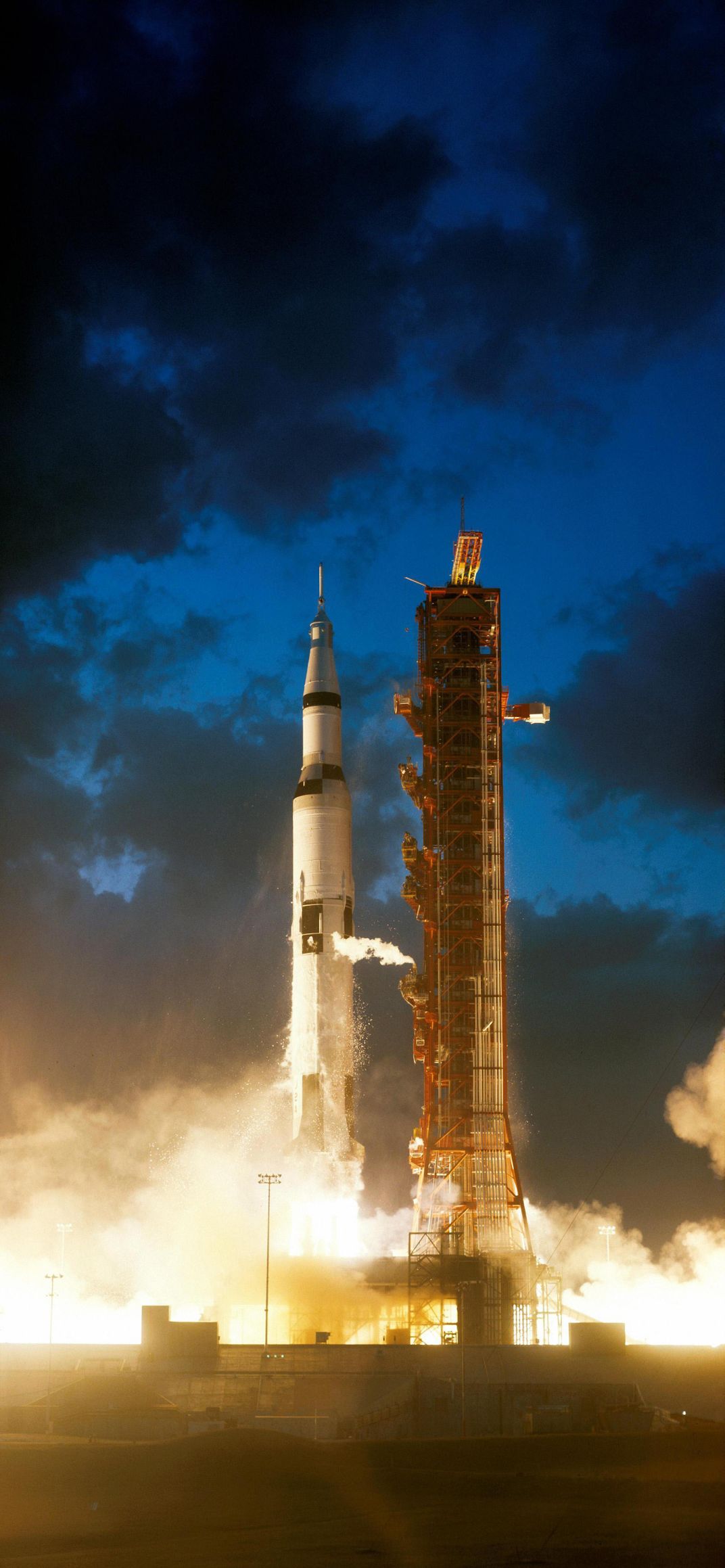
1968
October 11 | After a Low Point, High Performance
The first three-man crew is launched into Earth orbit on Apollo 7. Commander Wally Schirra and crewmates Walt Cunningham and Donn Eisele completed an exacting flight test of the Apollo Command and Service Modules. Among the most important tests were eight successful burns of the Service Module engine, critical for propelling the CSM back home from the moon and for other maneuvers on which the success of a lunar mission depended. Despite crankiness brought on by a cold, fatigue, and the stress of trying out a spacecraft heavily modified after disaster, the crew flew a near-perfect, 11-day mission. Apollo 7 also succeeded in its unwritten objective: to raise the spirits of a grief-stricken workforce and recover the momentum lost in the tragedy of the Apollo 1 fire.
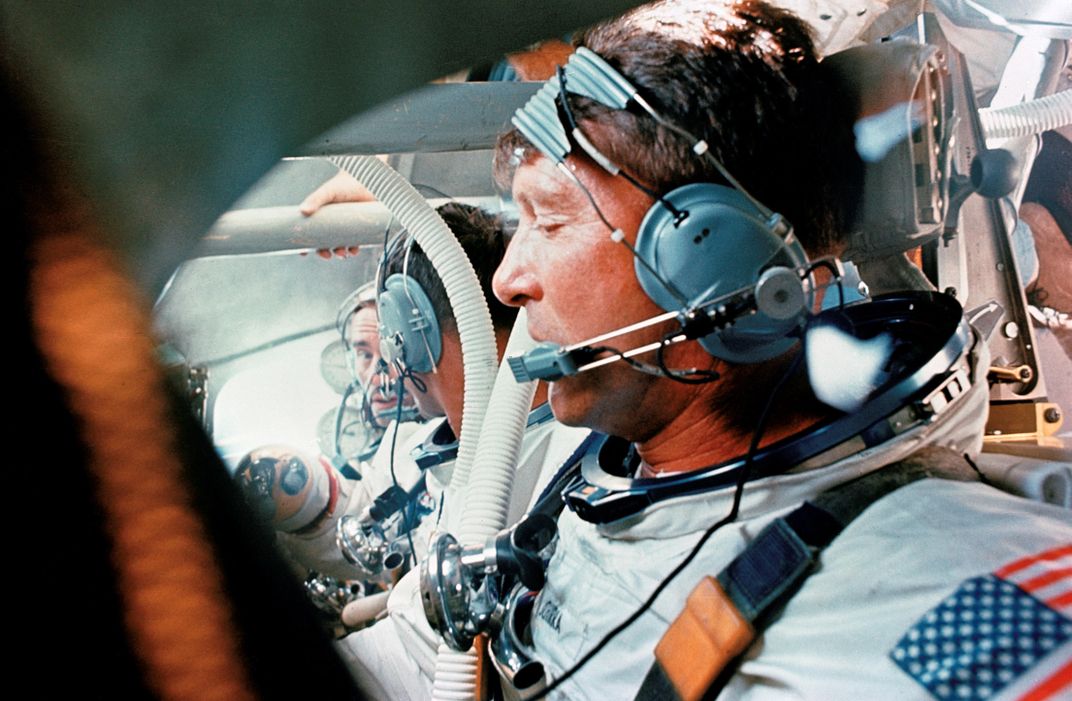
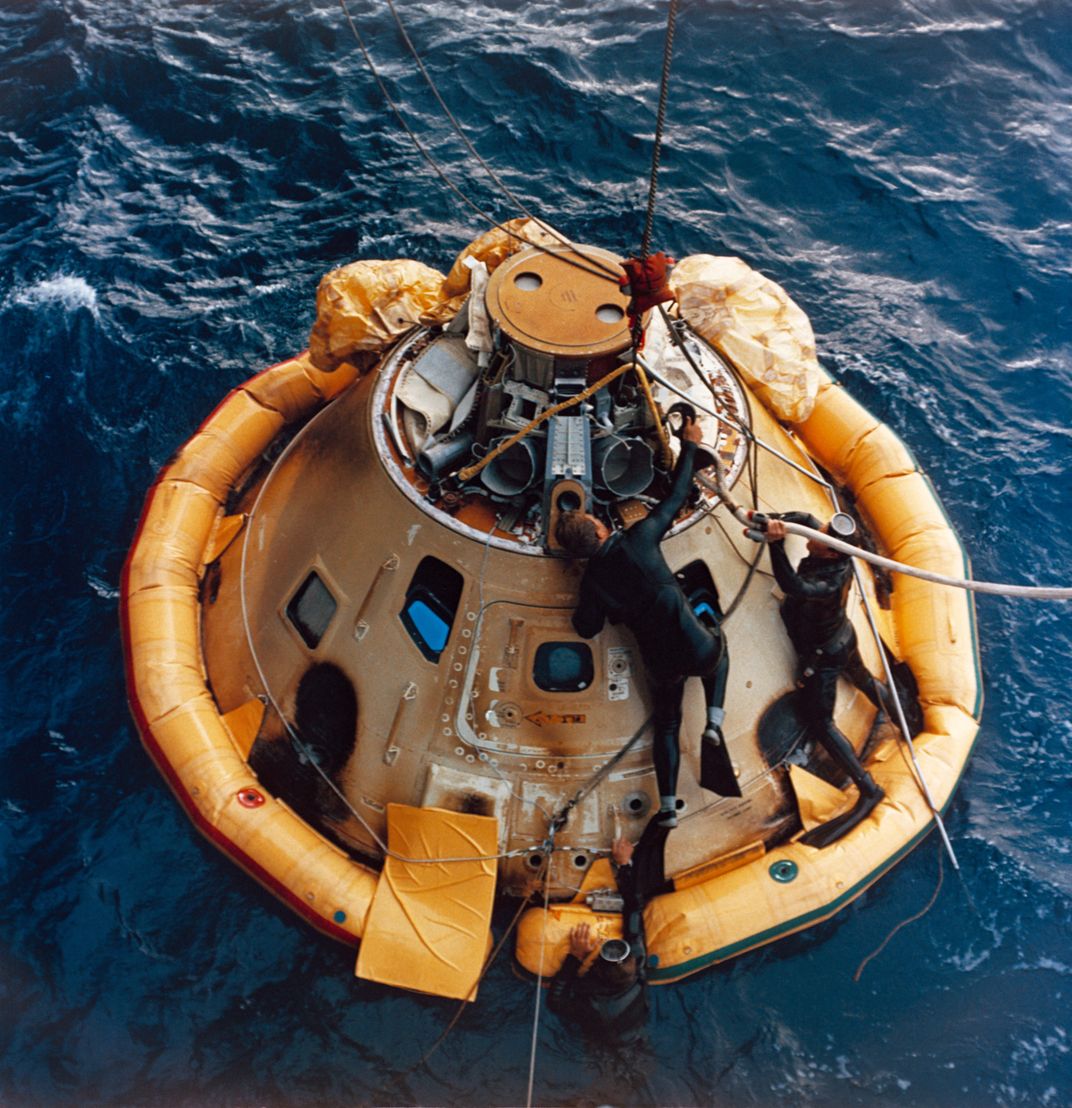
December 24 | Heaven and Earth
Men from Earth reach lunar orbit. When the Apollo 8 astronauts slowed their spacecraft to be captured by the moon’s gravity (by firing the Service Module engine for four minutes), they entered lunar orbit in darkness. As they progressed in their orbit, they crossed the terminator—the line between night and day—and sunlight began to illuminate the surface.The cockpit recorder captured the moment:
Jim Lovell: Hey, I got the moon.
Bill Anders: Do you?
Lovell: Right below us.
Commander Frank Borman: Okay.
Anders: It is below us?
Lovell: Yes, and it’s...
Anders: Oh, my God!
A little over 16 hours later, on their ninth orbit, the astronauts broadcast a video of the moon for the whole world to see, while they read verses from the Bible’s book of Genesis. At the time, it was the most watched television broadcast in history. Apollo 8 is also responsible for one of the most famous photographs in history: Earth rising above the lunar horizon.
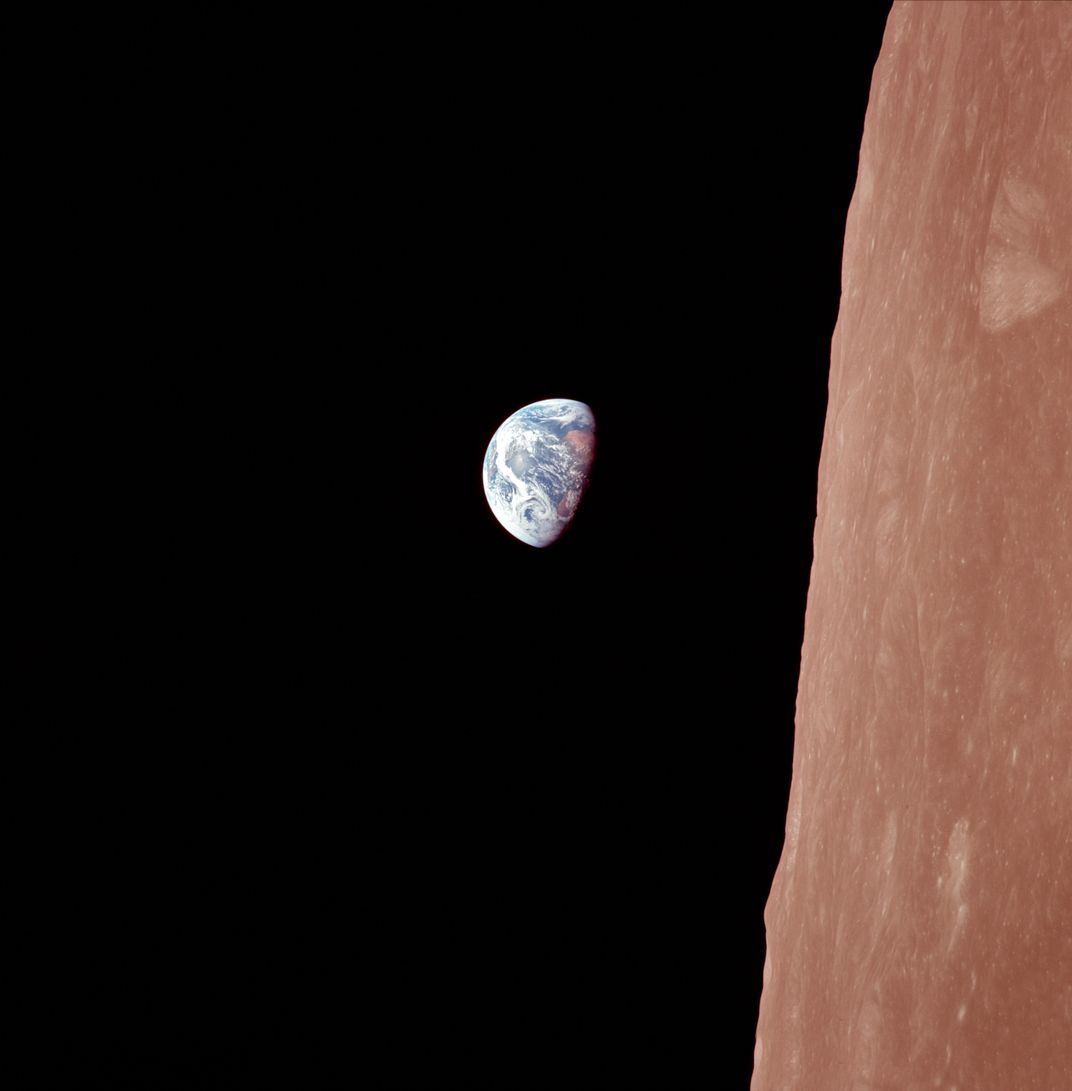
1969
March 3 | Spider and Gumdrop
On the Apollo 9 mission, astronauts Jim McDivitt and Rusty Schweickart test the Apollo Lunar Module.
Following an 11-minute ride to orbit and a couple of hours of system checks, Command Module Pilot Dave Scott separated the Command /Service Module (Gumdrop) from the Saturn V third stage, rotated it 180 degrees, and, aligning a pattern on his window with a T-shape target protruding from the top of the LM (Spider), guided the CSM’s probe into the LM’s socket, and docked. After the crew pressurized the docking tunnel, they removed the CM hatch, checked the latches on the docking ring, connected lines to feed electricity to the LM, and replaced the hatch. A detonator ejected the joined spacecraft from the third stage, which then fired its J-2 engine to reach solar orbit. On subsequent missions, the spacecraft would stay connected to the stage until the 225,000-pound-thrust J-2 gave it the push to get to the moon.
On the third day in orbit, McDivitt and Schweickart transferred to the LM, where they tested the descent engine. On the fifth day, the two spacecraft undocked and flew to a separation of 98 nautical miles. After a series of engine tests, the astronauts jettisoned the LM descent stage, and rejoined the CSM. The crew spent another six days in orbit to further test the CSM. Just before re-entry, they jettisoned the Service Module. Apollo 9 splashed down in the Atlantic on March 13. The next mission would be a repeat of this one, except the maneuvers would be flown in lunar orbit.
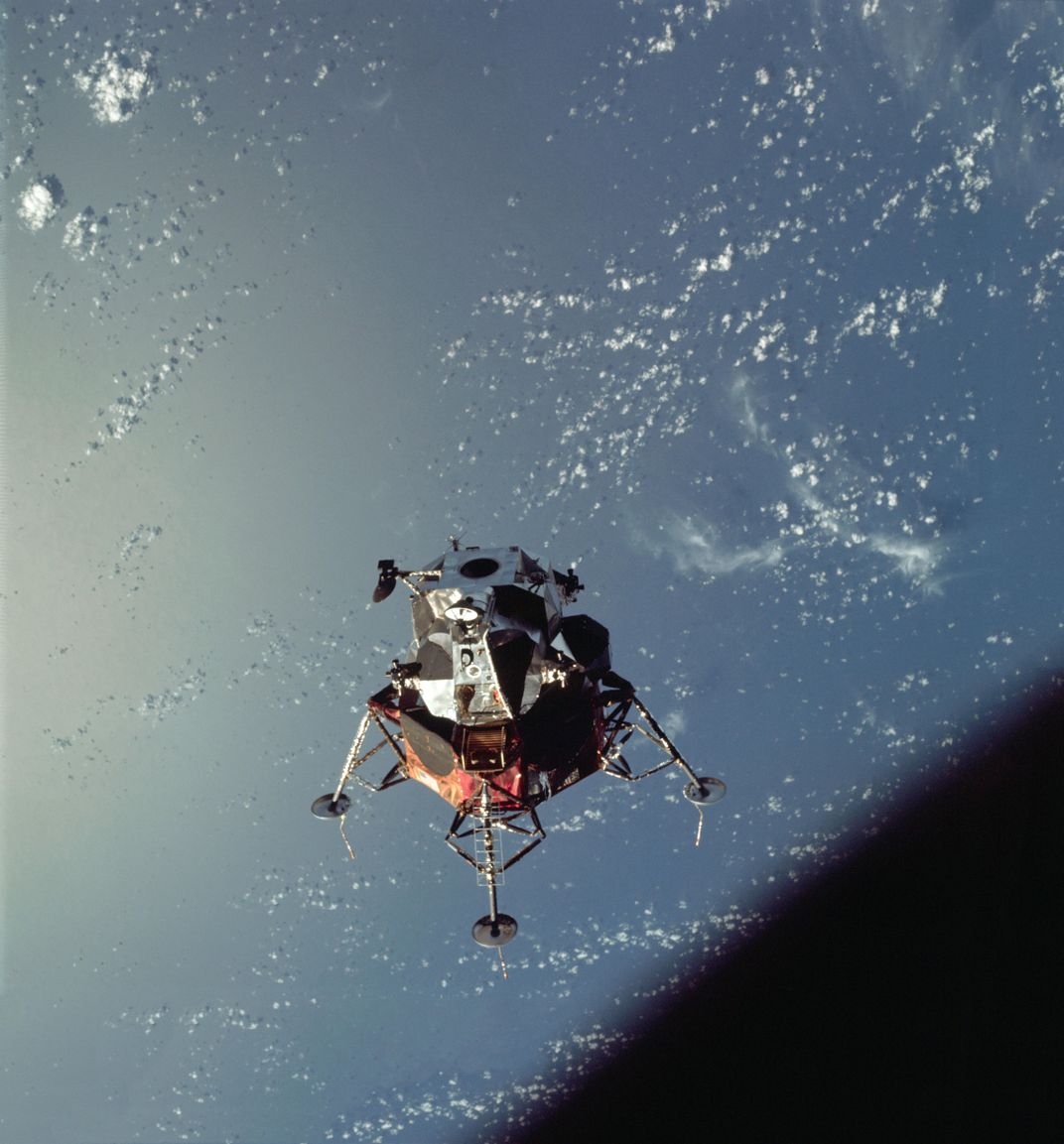
May 22 | Everything but Land
Apollo 10 flies to within nine miles of the moon.
Astronauts Tom Stafford, John Young, and Gene Cernan reached lunar orbit about 76 hours after their May 18 launch. After a day in orbit, the two spacecraft separated, and Stafford and Cernan descended in the LM to survey and photograph Apollo 11’s landing site in the Sea of Tranquility. They then jettisoned the descent stage and fired the LM’s ascent engine to rejoin the mothership.
Apollo 10 was only the third test flight of the Lunar Module, built by the Grumman Aircraft Engineering Corporation of Long Island. The spacecraft stood 23 feet tall, from footpad to antenna tip, and rested on long, spidery legs (thus its Apollo 9 name “Spider”; on Apollo 10, the LM was called “Snoopy” and the CM, “Charlie Brown”). The legs compressed to absorb the shock of touchdown: a lower, inner cylinder sliding into an upper, outer one.
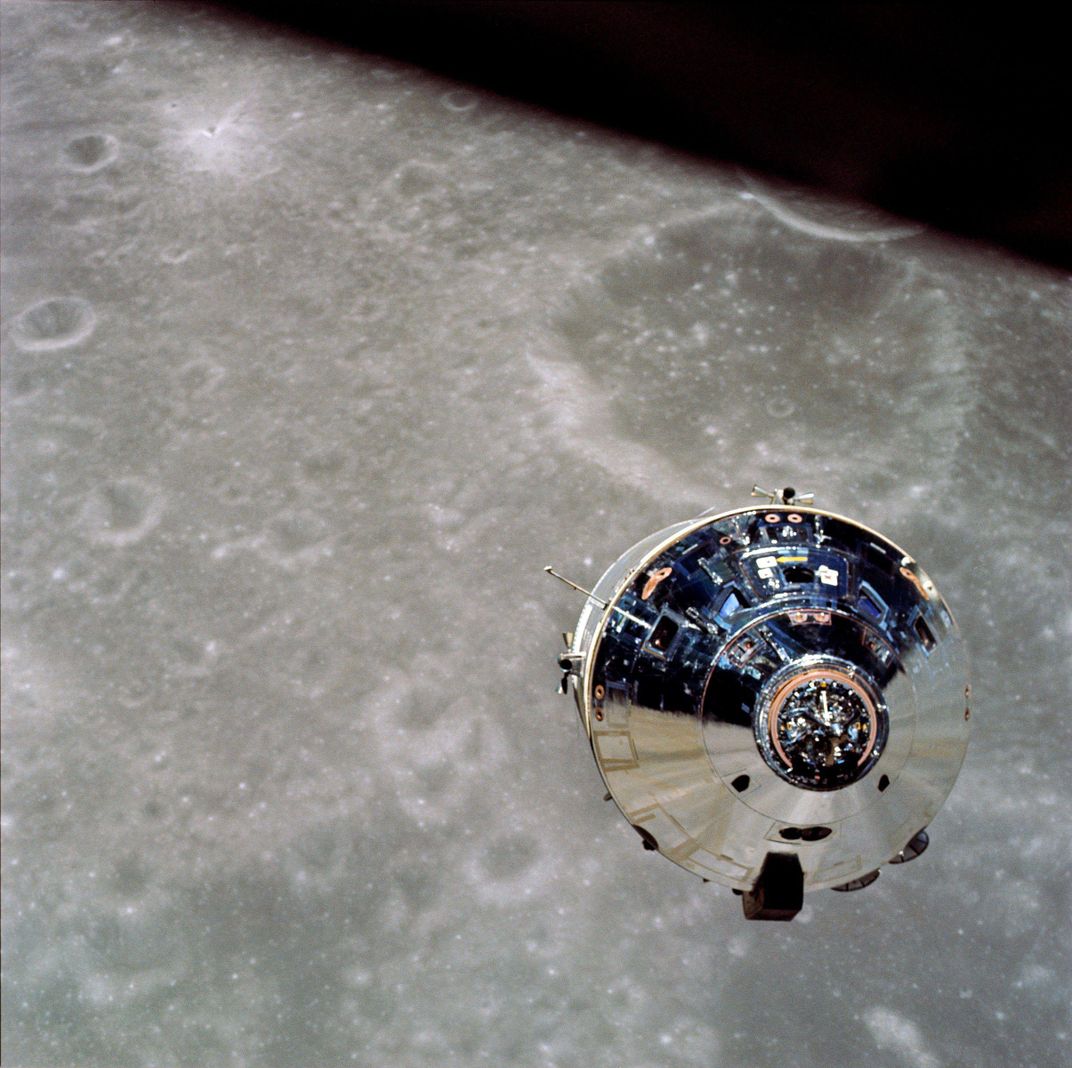
The two stages of the spacecraft each held an item that was non-redundant—a rarity in the Apollo program. Neither the LM’s descent engine, responsible for the complex maneuvers required to take the lunar module from orbit to a soft landing, or its ascent engine, responsible for lifting the upper stage from the moon, had a backup. Both had to work. They underwent a first flight test in January 1968 on the uncrewed Apollo 5 mission. Only 18 months later, a pair of engines landed on—and one lifted off from—the moon.
1969
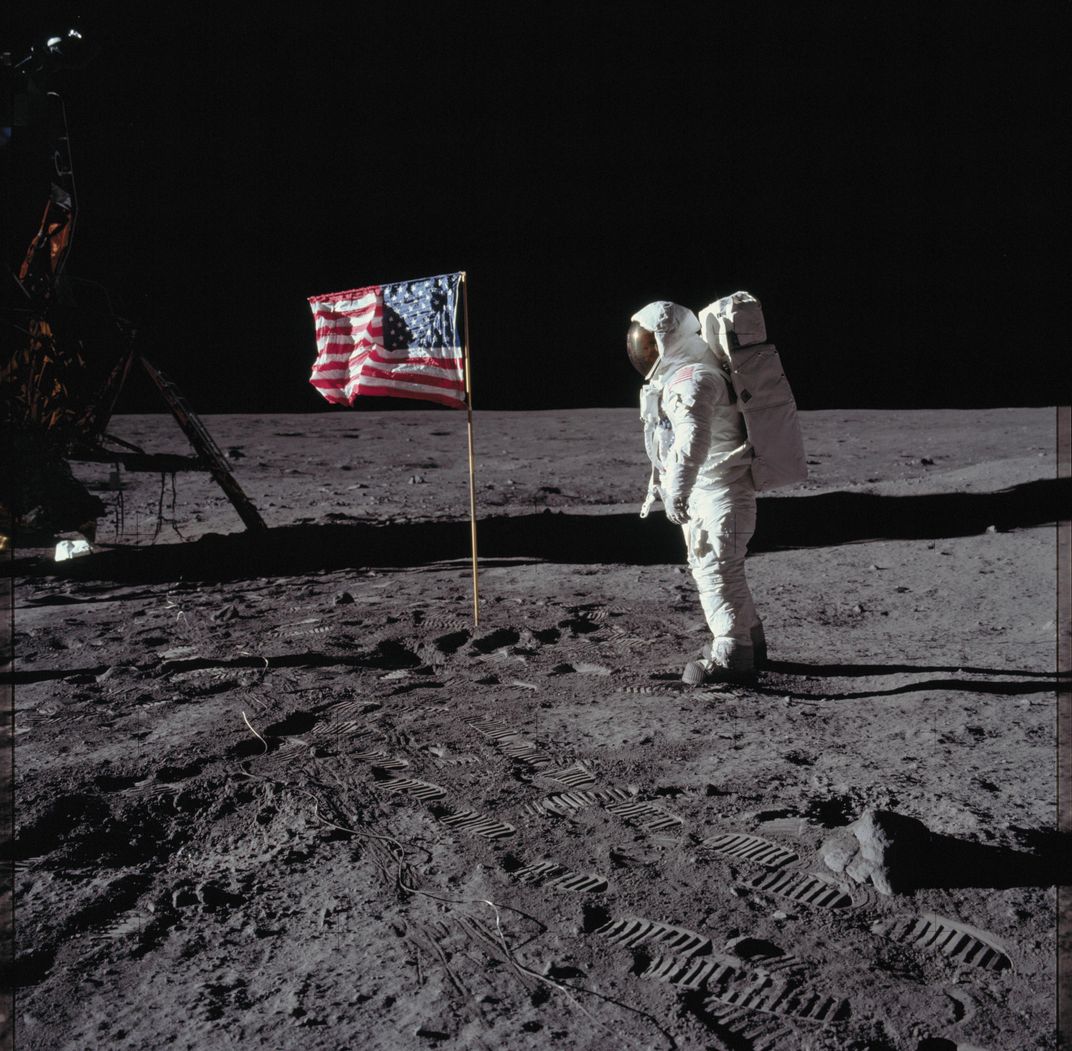
July 20 | On the Moon
The Apollo 11 Eagle lands, and Neil Armstrong becomes the first man to walk on the moon. An estimated 530 million people watch the telecast of Armstrong’s first steps.
The Eagle had undocked from Columbia two and a half hours earlier and followed nearly the same descent path as the Apollo 10 astronauts had flown. Eight years of superhuman effort rode along with Armstrong and Buzz Aldrin on the last 70 miles of their journey and with Michael Collins orbiting above them. When the deadline had been set, neither the spacecraft nor the rocket that launched them had been invented. There was no guidance system, no launch pad, little experience with spaceflight, and little knowledge of the destination.
NASA had made sure that the astronauts had received generous press coverage, but what still remained for 530 million people to wonder was what kind of men would actually do it. They were the kind who were capable of intense focus and the ability to hold in their heads simultaneously the procedures for at least two courses of action—abort or land—as the famous false alarms sounded during their descent, and the decision was made: Land. Armstrong was the kind of man who, after dodging boulders the size of small cars, described the landing to his biographer years later by saying, “I spent more time trying to arrest translational velocity than I thought would be necessary.”
Armstrong loved airplanes, from the time of his first flight, at age six, in a Ford Tri-motor. He took with him to the moon small pieces of the Wright brothers’ aircraft that had made the world’s first flight only 66 years before his lunar flight. He was the kind of man who understood the connection between the two.
/https://tf-cmsv2-smithsonianmag-media.s3.amazonaws.com/filer/ee/aa/eeaa09b2-1b31-4e77-b865-c26919465d5a/05e_ce14_apollo2019_simulatorel-1999-00385_live.jpg)